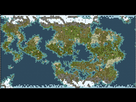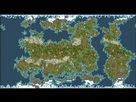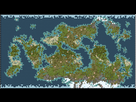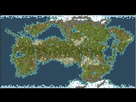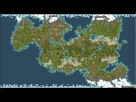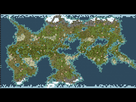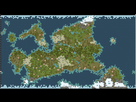@heinous_hat : I've spent the last 45 minutes generating Tectonic samples in the WB and I must say I am quite happy with it now. First, increasing map size did have a huge impact on the quality of the result. Second, after many tests, I've been able to come up with quite satisfactory results.
There are two things I tried to avoid: ugly, massive Pangaeas that look like polygons dropped on the map; and its polar opposite, an abundance of small landmasses that give a Small Continent/Large Islands feeling. I want strategic depth inland and I want naval civs to be balanced, neither OP nor UP. Plus, the sheer abundance of land is also a big factor.
I discovered that the Islands setting is very important. For a given % of land, less islands means that continents will be larger, or that one-tile islands will be merged into more relevant large islands. This is a big improvement. On the one hand, it may salvage a small-continentish setting by making the landmasses bulkier. On the other hand, it may alleviate the Pangaea issue by creating Australias or Madagascars. It can also remove coastal water and thus make Astronomy more relevant. Besides, less islands is also fairer for the AI, which has a tendency to lose settlers on irrelevant Falklands-like tiles. Overall, the results improved substantially after I reduced Islands frequency. Besides, setting Islands to None doesn't remove them entirely; there are still a few one-tile ones left, and there will be large islands with this setting, but no archipelago. I strongly suggest you experiment with Few or None to Islands.
Besides, in my opinion, any Sea Level above Low has too high a risk to generate scarce land, so I avoid raising it. Likewise, I stick with More regarding land.
When it comes to Plate, More Plates help avoid a blocky Pangaea. However, it may also result in the small continent feeling I described above; with the other settings set as I describes though, the risk is low.
Finally, I avoid blocky continent as the risk of a fat rectangle dropped on the map is too high. Standard and Snaky are both valid choice provided the options are set as above; the choice depends on what risk I want to minimize: Pangaea or scarce land + small continents.
The other options are left at default values.
Anyway, thanks for making me try this map again!









 I want strategic resources to be really rare to avoid mass Knight wars and Factories/Seaports/Train Stations in every city. I want Civs to fight for these resources...
I want strategic resources to be really rare to avoid mass Knight wars and Factories/Seaports/Train Stations in every city. I want Civs to fight for these resources... .The color would likely be referring to the continent art style (as per the key in WB)... so resource totals, tile counts, percentages etc would be relative to the "continent" as determined by the tile painting method. It's not ideal for analytical purposes... you can have 1 or 2 tile isthmuses connecting otherwise distinct landmasses that get painted with a common art style. That could connect parts or all of the world even if the terrain is impassable. It's even less useful with PerfectWorld/Communitas which mixes tile art. So, yeah... the numbers aren't terribly useful in this case. You'd need to see the whole map.
.The color would likely be referring to the continent art style (as per the key in WB)... so resource totals, tile counts, percentages etc would be relative to the "continent" as determined by the tile painting method. It's not ideal for analytical purposes... you can have 1 or 2 tile isthmuses connecting otherwise distinct landmasses that get painted with a common art style. That could connect parts or all of the world even if the terrain is impassable. It's even less useful with PerfectWorld/Communitas which mixes tile art. So, yeah... the numbers aren't terribly useful in this case. You'd need to see the whole map. ). It can seemingly defy your will at times, but it also creates the most interesting terrain layout and body shapes (imho). Ideally, this script would have the capability to vary # of players according to land percentage and quality. I guess that's true for any map script, but more so here.
). It can seemingly defy your will at times, but it also creates the most interesting terrain layout and body shapes (imho). Ideally, this script would have the capability to vary # of players according to land percentage and quality. I guess that's true for any map script, but more so here.


